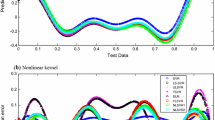Abstract
Generalized eigenvalue proximal support vector regressor (GEPSVR) determines a pair of \(\epsilon\)-insensitive bounding regressors by solving a pair of generalized eigenvalue problem. On the lines of GEPSVR, in this paper we propose a novel regressor for the simultaneous learning of a function and its derivatives, termed as GEPSVR of a Function and its Derivatives. The proposed method is fast as it requires the solution of a pair of generalized eigenvalue problems as compared to the solution of a large Quadratic Programming Problem required in other existing approaches. The experiment results on several benchmark functions of more than one variable proves the efficacy of our proposed method.
Similar content being viewed by others
References
Antonio J, Martin H, Santos M, Lope J (2010) Orthogonal variant moments features in image analysis. Inf Sci 180:846–860
Burges C (1998) A tutorial on support vector machines for pattern recognition. Data Min Knowl Discov 2(2):121–167
Chen C, Zhang J, He X, Zhou Z (2011) Non-parametric Kernel learning with robust pairwise constraints. Int J Mach Learn Cybern. doi:10.1007/s13042-011-0048-6
Ebrahimi T, Garcia G, Vesin J (2002) Joint time-frequency-space classification of EEG in a braincomputer interface appplication. J Appl Signal Process 1:713–729
Guarracino MR, Cifarelli C, Seref O, Pardalos PM (2007) A classification method based on generalized eigenvalue problems. Optim Methods Softw 22(1):73–81
Khemchandani R, Chandra S (2006) Regularized least squares twin SVR for the simultaneous learning of a function and its derivative. In: IJCNN, pp 1192–1197
Khemchandani R, Chandra S (2007) Twin support vector machines for pattern classification. IEEE Trans Pattern Anal Mach Intell 29:905–910
Khemchandani R, Chandra S (2008) Regularized least squares support vector regression for the simultaneous learning of a function and its derivatives. Inf Sci 178:3402–3414
Joachims T (1999) Making large-scale SVM learning practical. In: Schölkopf B, Burges C, Smola A (eds) Advances in kernel methods: support vector learning. MIT Press, Cambridge, MA
Julier SJ, Uhlmann JK (2004) Unscented filtering and nonlinear estimation. In: Proceedings of the IEEE, pp 401–422
Khemchandani R, Jayadeva Chandra S (2009) Regularized least squares fuzzy support vector regression for financial time series forecasting. Expert Syst Appl 36:132–138
Khemchandani R, Karpatne A, Chandra S (2011) Generalized eigenvalue proximal support vector regressor. Expert Syst Appl 38:13136–13142
Khemchandani R, Karpatne A, Chandra S (2013) Twin support vector regression for the simultaneous learning of a function and its derivatives. Int J Mach Learn Cybern 4:51–63
Khemchandani R, Goyal K, Chandra S (2016) TWSVR: regression via twin support vector machine. Neural Netw 74:14–21
Lagaris IE, Likas A, Fotiadis D (1998) Artificial neural networks for solving ordinary and partial differential equations. IEEE Trans Neural Netw 9:987–1000
Lázarao M, Santamaŕia I, Péreze-Cruz F, Artés-Rodŕiguez A (2003) SVM for the simultaneous approximation of a function and its derivative. In: Proceedings of the 2003 IEEE international workshop on neural networks for signal processing(NNSP), Toulouse, France, pp 189–198
Lázarao M, Santamaŕia I, Péreze-Cruz F, Artés-Rodŕiguez A (2005) Support vector regression for the simultaneous learning of a multivariate function and its derivative. Neurocomputing 69:42–61
Liu Z, Wu Q, Zhang Y, Chen CLP (2011) Adaptive least squares support vector machines filter for hand tremor canceling in microsurgery. Int J Mach Learn Cybernet 2(1):37–47
Managasarian OL, Wild EW (2006) Multisurface proximal support vector classification via generalized eigenvalues. IEEE Trans Pattern Anal Mach Intell 28(1):69–74
Osuna E, Freund R, Girosi F (1997) Training support vector machines: an application to face detection. In: IEEE computer society conference on computer vision and pattern recognition, pp 130–136
Parlett BN (1998) The symmetric eigenvalue problem. Classics in applied mathematics, vol 20. Society for Industrial and Applied Mathematics(SIAM)(2), Philadelphia
Peng X (2010) TSVR: an efficient twin support vector machine for regression. Neural Netw 23:365–372
Tikhonov AN, Arsenin VY (1977) Solution of ill posed problems. Wiley, New York
Vapnik V.N(1998). Statistical learning theory. Wiley, New York
Xiao JZ, Wang HR, Yang X, Gao Z (2011) Multiple faults diagnosis in motion system based on SVM. International Journal of Machine Learning and Cybernetics. doi:10.1007/s13042-011-0035-y
Zheng S (2011) Gradient descent algorithms for quantile regression with smooth approximation. International Journal of Machine Learning and Cybernetics 2(3):191–207
Acknowledgements
The authors would like to thank Dr. Aparna Mehra for her support during the preparation of the manuscript. We are also extremely thankful to the editor and learned referees for their most valuable comments/suggestions which has further improved the content of the paper.
Author information
Authors and Affiliations
Corresponding author
Rights and permissions
About this article
Cite this article
Khemchandani, R., Goyal, K. & Chandra, S. Generalized eigenvalue proximal support vector regressor for the simultaneous learning of a function and its derivatives. Int. J. Mach. Learn. & Cyber. 9, 2059–2070 (2018). https://doi.org/10.1007/s13042-017-0687-3
Received:
Accepted:
Published:
Issue Date:
DOI: https://doi.org/10.1007/s13042-017-0687-3




